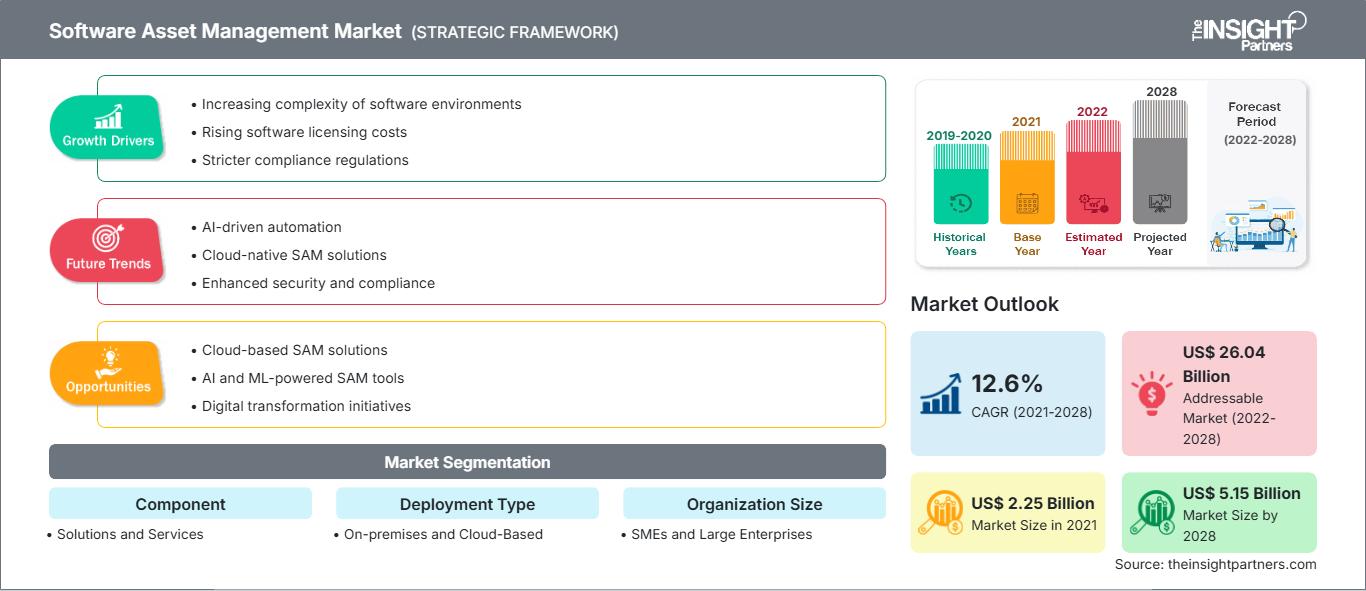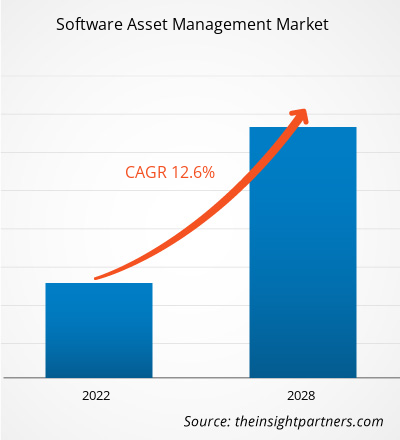[Forschungsbericht]Der Markt für Software Asset Management soll von 2.250,37 Millionen US-Dollar im Jahr 2021 auf 5.150,51 Millionen US-Dollar im Jahr 2028 wachsen; die durchschnittliche jährliche Wachstumsrate (CAGR) von 12,6 % wird von 2021 bis 2028 geschätzt.
Die Verwaltung von Systemen, Regeln und Verfahren, die die Beschaffung, Implementierung, Nutzung, Wartung und Entsorgung von Softwareanwendungen innerhalb eines Unternehmens ermöglichen, wird als Software Asset Management (SAM) bezeichnet. Der Markt für Software Asset Management ist ein Bestandteil des IT-Asset-Managements und soll sicherstellen, dass Unternehmen Lizenzvereinbarungen einhalten und nicht zu viel für Software ausgeben. Die Identifizierung von Software-Assets, die Gültigkeit von Endbenutzer-Lizenzvereinbarungen (EULAs) und die angemessene Nutzung freier Software sind entscheidende Ziele jedes SAM-Vorhabens. SAM-Dokumentation kann Unternehmen vor Piraterieklagen schützen, unbeabsichtigten Lizenzmissbrauch minimieren und Kontrolle über Schattensoftware im Netzwerk ermöglichen.
Software Asset Management in großen Unternehmen kann so komplex sein, dass es die Entwicklung und Pflege einer Datenbank erfordert, die Informationen über Softwarekäufe, Abonnements, Lizenzen und Patches enthält. Ein solches Team ist häufig für die Erneuerung von Softwarelizenzen, die Aushandlung neuer Lizenzverträge sowie die Erkennung und Entfernung selten oder nie genutzter Software verantwortlich. Der Software Asset Management-Markt prüft die Anzahl der erworbenen Softwarelizenzen und gleicht sie mit der Anzahl der installierten Lizenzen ab, um die Informationsbeschaffung aus zahlreichen Inventarquellen für Mobilgeräte, Desktops, Rechenzentren und die Cloud zu automatisieren. SAM-Tools können auch den Überblick über die verbleibenden Lizenzen behalten. Um die Kosten niedrig zu halten, kann dieses Wissen genutzt werden, um nicht genutzte Software zu löschen oder neu zuzuweisen.
Passen Sie diesen Bericht Ihren Anforderungen an
Sie erhalten kostenlos Anpassungen an jedem Bericht, einschließlich Teilen dieses Berichts oder einer Analyse auf Länderebene, eines Excel-Datenpakets sowie tolle Angebote und Rabatte für Start-ups und Universitäten.
Markt für Software-Asset-Management: Strategische Einblicke

-
Holen Sie sich die wichtigsten Markttrends aus diesem Bericht.Dieses KOSTENLOSE Beispiel umfasst Datenanalysen, die von Markttrends bis hin zu Schätzungen und Prognosen reichen.
Auswirkungen der COVID-19-Pandemie auf den Software Asset Management-Markt
Die COVID-19-Pandemie hat dem Software Asset Management-Markt zugutegekommen. Unternehmen stehen aufgrund der COVID-19-Pandemie vor neuen Herausforderungen, wie beispielsweise der Entwicklung von Remote-Arbeitsumgebungen. Der COVID-19-Ausbruch hat die Notwendigkeit verdeutlicht, digitale Technologien zu übernehmen und das Potenzial von Software Asset Management-Lösungen und -Services zu nutzen, um Lizenzen und Kosten zu optimieren und den ROI von IT-Assets zu steigern. Darüber hinaus hat der Ausbruch der Pandemie im Jahr 2020 eine Reihe von Herausforderungen für die globalen Marktaktivitäten mit sich gebracht. Da die Gesundheitsinfrastrukturen der Industrieländer aufgrund steigender Fallzahlen zusammengebrochen sind, erfordert der öffentliche Gesundheitsnotstand ein Eingreifen von Regierung und Marktteilnehmern. Sie müssen durch gemeinsame Forschungs- und Entwicklungsinitiativen zur Wiederbelebung des Marktbetriebs und der Umsätze beitragen, um die Verluste im Prognosezeitraum bis 2028 auszugleichen. Die erhöhten Investitionen sind zudem ein gutes Zeichen für die Branche in den kommenden Jahren.
Markteinblicke – Markt für Software-Asset-Management
Steigender Bedarf an Asset-Lifecycle-Management steigert die Nachfrage nach Software-Asset-Management
Alle Verfahren und IT-Infrastrukturnutzer müssen die Software-Assets des Unternehmens während ihres gesamten Lebenszyklus verwalten, regulieren und schützen. IT-Asset-Management (ITAM), IT-Service-Management (ITSM) und Hardware-Asset-Management (HAM) sind Teilbereiche des Software-Asset-Managements (SAM). ITAM zielt darauf ab, das Software- und Hardware-Asset-Management zu verbessern und gleichzeitig Kosteneinsparungen zu optimieren und Auditrisiken zu minimieren. Moderne Unternehmen betrachten Software als integralen Bestandteil ihres täglichen Betriebs. Durchschnittlich setzt ein Unternehmen 288 Anwendungen ein, um Mitarbeiter bei verschiedenen Aufgaben zu unterstützen. Mit der Implementierung eines erfolgreichen Asset-Lifecycle-Managements (LCAM) können strategische Unternehmen bestimmen, wann ein Asset seine Spitzenleistung erreicht und wie lange es dem Unternehmen noch zur Verfügung steht. Blissfully beispielsweise ist eine Software-Asset-Management- und Software-as-a-Service-(SaaS)-Management-Anwendung, die dabei helfen kann, Kosten zu sparen, alle Softwareanbieter zu verwalten, die Produktivität zu steigern und die Sicherheit des Softwaresystems zu erhöhen. Der steigende Bedarf an Asset-Lifecycle-Management steigert somit die Nachfrage nach Software-Asset-Management.
Komponentensegment-Einblicke – Markt für Software-Asset-Management
Basierend auf Komponenten ist der Markt für Software-Asset-Management in Lösungen und Services unterteilt. Software-Asset-Management-Lösungen unterstützen Betriebsleiter von Rechenzentren dabei, alle Assets zu identifizieren, zu lokalisieren, zu visualisieren und zu verwalten sowie die Kapazität für zukünftiges Wachstum zu planen. Die Implementierung eines Software-Asset-Management-Programms hat einen taktischen Zweck: die Anzahl der erworbenen Softwarelizenzen an die Anzahl der tatsächlich genutzten Lizenzen anzupassen. Ein erfolgreiches Software-Asset-Management-Programm muss sicherstellen, dass die gesamte installierte Software gemäß den Bedingungen der jeweiligen Lizenzvereinbarung des Anbieters verwendet wird und die Anzahl der erworbenen Lizenzen mit der tatsächlich genutzten Menge in Einklang steht. Im Falle einer Prüfung durch einen Softwareanbieter oder einen Drittanbieter wie die Business Software Alliance (BSA) können Unternehmen die Haftung im Zusammenhang mit Softwarepiraterie reduzieren.
Segmenteinblicke nach Bereitstellungstyp – Markt für Software-Asset-Management
Basierend auf dem Bereitstellungstyp wird Software-Asset-Management in On-Premise und Cloud-basiert unterteilt. Cloud-basierte Software-Asset-Management-Lösungen sind bequemer auf verschiedenen Geräten mit unterschiedlichen Bildschirmgrößen (Desktop, Laptop, Tablet, Handheld-Geräte und Smartphones) zu verwenden. Daten von RFID, Barcodes und NFC können ebenfalls in der Cloud gespeichert werden, was den Abruf erleichtert. Cloud-basierte Systeme eignen sich aufgrund ihres einfachen Zugriffs ideal für mehrere Standorte und eine Kombination aus internen und externen Asset-Audits. Das Hochladen von Asset-Fotos und das Hinzufügen von Anmerkungen von mehreren Geräten aus ist in der Regel einfacher. Eine cloudbasierte Software-Asset-Management-Lösung kann Versionskontrolle, Auditing und Mehrfachgenehmigungsketten problemlos vereinfachen.
Einblicke in die Segmente Organisationstyp
Basierend auf dem Organisationstyp kann der Markt für Software-Asset-Management in kleine und mittlere Unternehmen sowie große Unternehmen unterteilt werden. Große Unternehmen können enorme Investitionen in High-End-Software tätigen, um die Produktivität des Unternehmens zu steigern. Größere Unternehmen benötigen ein SAM-Tool. Manuelle Prozesse können mithilfe eines Software-Asset-Management-Tools automatisiert, beschleunigt und verbessert werden. Darüber hinaus hilft Software-Asset-Management Unternehmen unterschiedlicher Branchen dabei, die Leistung und Agilität ihrer IT-Assets effektiv zu verbessern.
Einblicke in die Segmente Branchenvertikale – Markt für Software-Asset-Management
Basierend auf den Branchenvertikalen ist der Markt für Software-Asset-Management in Regierung, Einzelhandel und Konsumgüter, Gesundheitswesen und Biowissenschaften, BFSI, Medien und Unterhaltung, Fertigung, IT und Telekommunikation und andere segmentiert. Digitale Technologien verändern die Geschäftsstrategie der Fertigungsindustrie. Technologie wird in Industrie 4.0 voraussichtlich eine massive Rolle spielen. Software-Asset-Management wird ein Schlüsselelement dieses neuen Fertigungszeitalters sein.
Die Marktteilnehmer konzentrieren sich auf Produktinnovationen und -entwicklungen, indem sie fortschrittliche Technologien und Funktionen integrieren, um wettbewerbsfähig zu bleiben. Laut Snow Software, dem weltweit führenden Anbieter von Technologieinformationen, ist Snow Atlas die einzige integrierte Plattform, die von Grund auf entwickelt wurde, um Unternehmen dabei zu helfen, ihre Technologieinvestitionen sowohl vor Ort als auch in der Cloud zu identifizieren, zu überwachen und zu optimieren. Software- und Asset-Management (SAM), Software-as-a-Service (SaaS)-Management und IT-Service-Management (ITSM)-Integrationen, die als Service bereitgestellt werden, sind die ersten Lösungen, die auf der neuen Cloud-nativen Plattform zugänglich sind und in Lösungen für das Software-Zugriffsmanagement enthalten sind.
Basierend auf den Komponenten ist der Markt für Software-Asset-Management in Lösungen und Services segmentiert. Hinsichtlich der Bereitstellungsart wird das Software-Asset-Management in vor Ort und Cloud-basiert kategorisiert. Basierend auf dem Organisationstyp kann der Markt für Software-Asset-Management in kleine und mittlere Unternehmen sowie große Unternehmen unterteilt werden. Basierend auf der Branchenvertikale ist der Markt für Software-Asset-Management in die Bereiche Regierung, Einzelhandel & Konsumgüter, Gesundheitswesen & Biowissenschaften, BFSI, Medien & Unterhaltung, Fertigung, IT & Telekommunikation und andere segmentiert. Basierend auf der Region ist der globale Markt für Software-Asset-Management in Nordamerika, Europa, Asien-Pazifik, Naher Osten & Afrika sowie Südamerika segmentiert.
Markt für Software-Asset-Management
Markt für Software-Asset-Management
Die Analysten von The Insight Partners haben die regionalen Trends und Faktoren, die den Software Asset Management-Markt im Prognosezeitraum beeinflussen, ausführlich erläutert. In diesem Abschnitt werden auch die Marktsegmente und die geografische Lage in Nordamerika, Europa, dem asiatisch-pazifischen Raum, dem Nahen Osten und Afrika sowie Süd- und Mittelamerika erörtert.Umfang des Marktberichts zum Software Asset Management
| Berichtsattribut | Einzelheiten |
|---|---|
| Marktgröße in 2021 | US$ 2.25 Billion |
| Marktgröße nach 2028 | US$ 5.15 Billion |
| Globale CAGR (2021 - 2028) | 12.6% |
| Historische Daten | 2019-2020 |
| Prognosezeitraum | 2022-2028 |
| Abgedeckte Segmente |
By Komponente
|
| Abgedeckte Regionen und Länder |
Nordamerika
|
| Marktführer und wichtige Unternehmensprofile |
|
Dichte der Marktteilnehmer im Bereich Software Asset Management: Verständnis ihrer Auswirkungen auf die Geschäftsdynamik
Der Markt für Software Asset Management wächst rasant. Dies wird durch die steigende Nachfrage der Endnutzer aufgrund veränderter Verbraucherpräferenzen, technologischer Fortschritte und eines stärkeren Bewusstseins für die Produktvorteile vorangetrieben. Mit der steigenden Nachfrage erweitern Unternehmen ihr Angebot, entwickeln Innovationen, um den Bedürfnissen der Verbraucher gerecht zu werden, und nutzen neue Trends, was das Marktwachstum weiter ankurbelt.

- Holen Sie sich die Markt für Software-Asset-Management Übersicht der wichtigsten Akteure
Markt für Software-Asset-Management – Unternehmensprofile
- Microsoft Corporation
- Historische Analyse (2 Jahre), Basisjahr, Prognose (7 Jahre) mit CAGR
- PEST- und SWOT-Analyse
- Marktgröße Wert/Volumen – Global, Regional, Land
- Branchen- und Wettbewerbslandschaft
- Excel-Datensatz
Aktuelle Berichte
Verwandte Berichte
Erfahrungsberichte
Grund zum Kauf
- Fundierte Entscheidungsfindung
- Marktdynamik verstehen
- Wettbewerbsanalyse
- Kundeneinblicke
- Marktprognosen
- Risikominimierung
- Strategische Planung
- Investitionsbegründung
- Identifizierung neuer Märkte
- Verbesserung von Marketingstrategien
- Steigerung der Betriebseffizienz
- Anpassung an regulatorische Trends






















 Kostenlose Probe anfordern für - Markt für Software-Asset-Management
Kostenlose Probe anfordern für - Markt für Software-Asset-Management